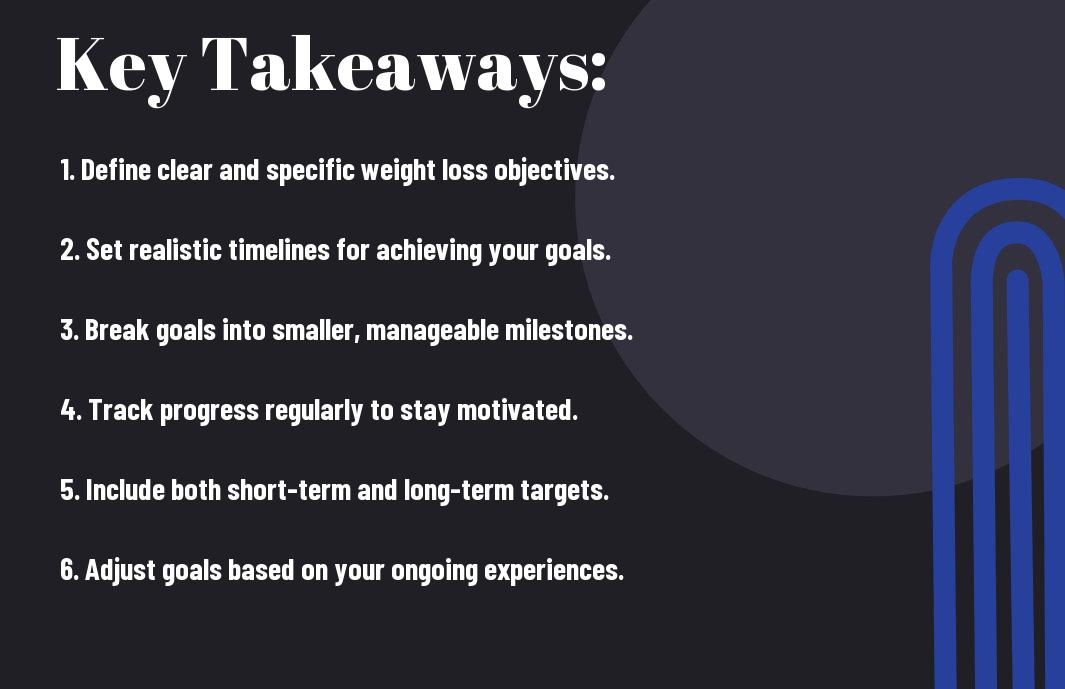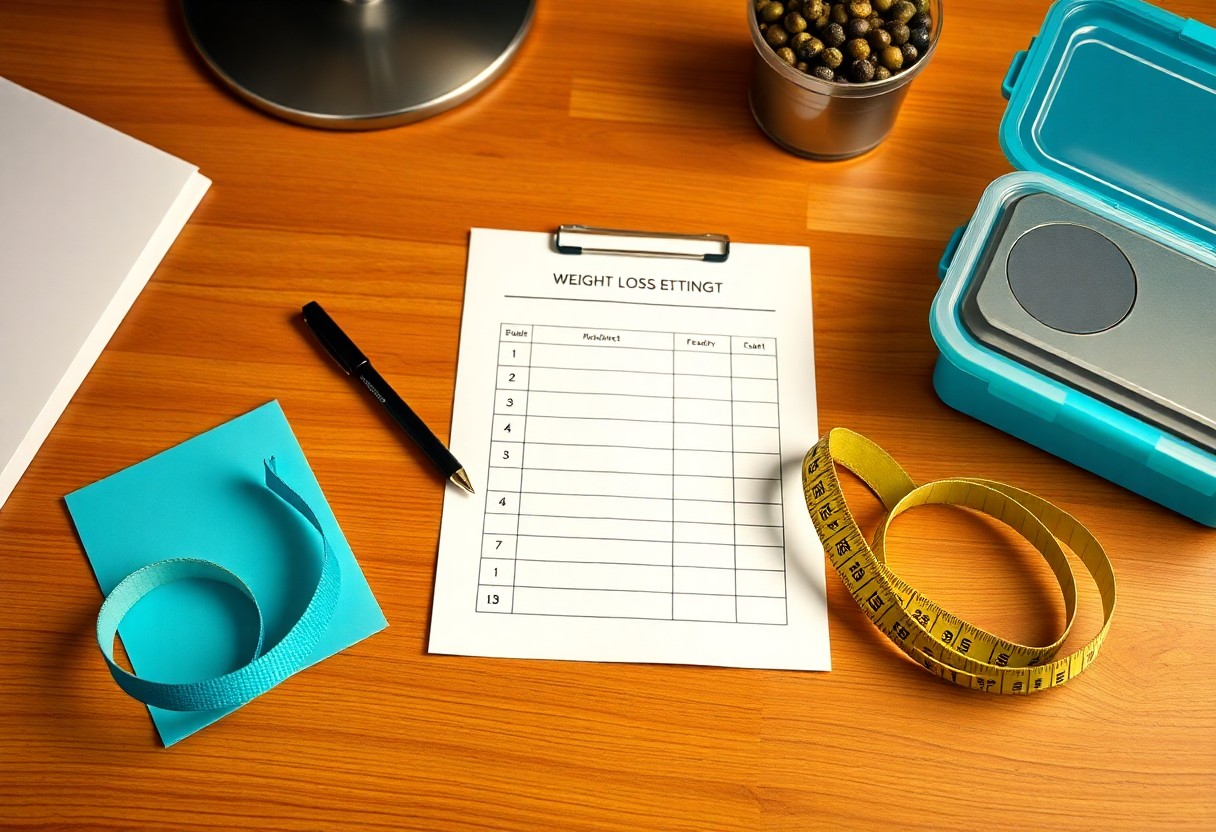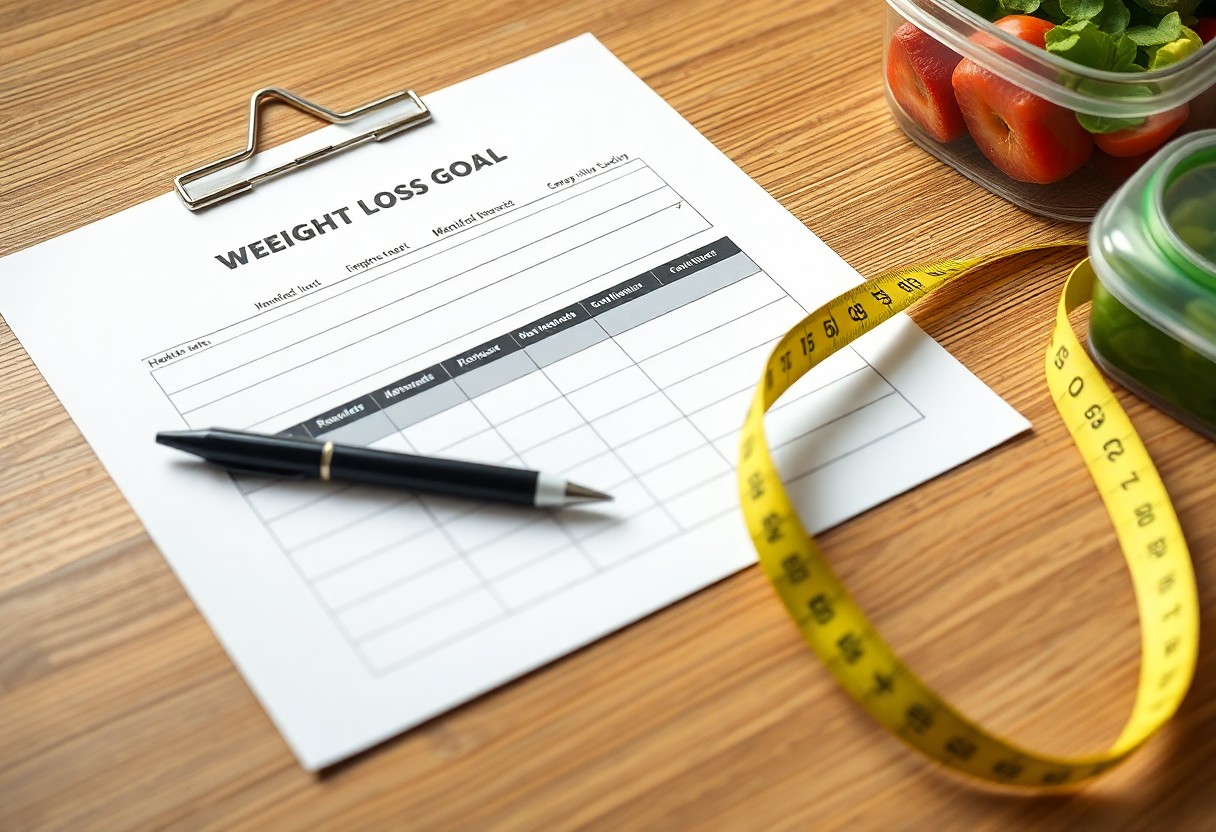You have the power to transform your weight loss journey by setting clear and achievable goals. A Weight Loss Goal Setting Worksheet serves as a practical tool to help you outline your objectives, track your progress, and stay motivated throughout your fitness endeavor. By defining specific targets and breaking them down into manageable steps, you can cultivate a sustainable approach to weight loss. In this post, you’ll learn how to effectively utilize this worksheet to foster accountability and success in your wellness journey.
Key Takeaways:
- Structured Approach: The worksheet provides a clear framework for setting and achieving weight loss goals.
- SMART Goals: It emphasizes the importance of formulating Specific, Measurable, Achievable, Relevant, and Time-bound objectives.
- Progress Tracking: Users can actively monitor their weight loss progress over time, making adjustments as needed.
- Motivation Boost: The worksheet encourages individuals to identify personal motivations for weight loss, enhancing commitment.
- Realistic Expectations: It promotes setting attainable goals to avoid frustration and maintain motivation.
- Behavioral Insights: Users are guided to reflect on behavioral patterns that may impact their weight loss journey.
- Accountability: The worksheet serves as a tool for establishing responsibility by sharing goals with others for support.
Understanding Weight Loss Goals
A well-defined weight loss goal is vital for guiding your journey towards improved health and well-being. By setting clear objectives, you enhance your focus and motivation, making it easier to track your progress. Understanding the nature of your goals will empower you to make sustained lifestyle changes, ultimately leading to successful outcomes.
Importance of Setting Specific Goals
Loss of direction can lead to frustration and failure. By establishing specific goals, you provide yourself with a roadmap to follow, making it simpler to gauge your progress and adjust your strategies as needed. Specific targets encourage accountability, helping you stay committed to your weight loss journey.
Types of Weight Loss Goals
Across your weight loss journey, your goals can take various forms that address different aspects of health and fitness. You may choose to set short-term, measurable objectives to gradually realize your ultimate aim. Here are several types to consider:
- Long-term goals: Overall weight loss targets over months or years
- Short-term goals: Smaller milestones to keep you motivated
- Behavioral goals: Focusing on daily habits, like exercising regularly
- Health-related goals: Aiming for improved blood pressure or cholesterol levels
- Fitness goals: Increasing your physical activity levels or building muscle
Any weight loss journey will benefit from diverse goal types.
| Goal Type | Description |
| Long-term | Weight loss target over an extended period |
| Short-term | Immediately achievable milestones |
| Behavioral | Focus on daily activities and habits |
| Health-related | Aim to improve specific metrics |
| Fitness | Increase activity levels or enhance strength |
Understanding these goal types can enhance your approach and commitment. By customizing your goals, you can cater to your personal needs, making your weight loss journey more achievable and enjoyable. You might want to set a blend of these to keep things dynamic and engaging.
- Identify your primary objective first
- Consider both qualitative and quantitative targets
- Adjust goals as you progress to avoid plateaus
- Regularly assess your progress and celebrate small victories
- Stay flexible and ready to adapt your strategy
Any approach you take should be personalized to fit your unique aspirations.
| Goal Aspect | Importance |
| Customization | Aligns with your lifestyle |
| Realistic | Ensures achievable and sustainable goals |
| Variety | Prevents monotony and keeps you engaged |
| Adaptability | Allows necessary adjustments as you progress |
| Evaluation | Encourages regular progress checks |


Creating Your Weight Loss Goal
Some people underestimate the importance of creating a clear weight loss goal. Establishing a specific target helps you stay focused and motivated throughout your journey. Aim for a weight that reflects a healthier version of you, and ensure it aligns with your personal health and fitness objectives. Documenting this goal will provide a reference point for tracking your progress and adjusting your strategies as necessary.
Defining Your Target Weight
Loss of excess weight often begins with defining your target weight, which should be achievable and tailored to your body’s needs. Consider factors such as your height, age, and overall health. Consulting a healthcare professional can provide valuable insight in establishing a realistic and healthy target.
Setting a Realistic Timeline
Around you, it may seem that quick fixes promise rapid weight loss, but sustainable changes take time. It’s important to set a timeline that feels attainable for your lifestyle and commitments. This helps in maintaining motivation while allowing room for lifestyle adjustments and setbacks.
In fact, establishing a realistic timeline helps you break down your weight loss goal into smaller, manageable milestones. For instance, losing 1-2 pounds per week is a healthy rate for long-term success. By setting short-term goals with deadlines, you can celebrate small achievements along the way, keeping you engaged and motivated to reach your ultimate target.

Developing a Personal Action Plan
Keep your weight loss journey focused by developing a personal action plan that outlines clear steps to reach your goals. This plan should detail specific, measurable actions you can take on a daily or weekly basis. Break down larger goals into smaller, manageable milestones, setting deadlines to keep yourself accountable. Regularly review and adjust your action plan as needed to ensure you stay on track and motivated throughout your weight loss process.
Nutrition and Meal Planning
Above all, effective nutrition and meal planning are key to achieving your weight loss goals. Start by evaluating your current eating habits and identifying areas for improvement. Create a weekly meal plan that includes balanced meals and snacks. Make sure to prioritize whole, nutrient-dense foods while limiting processed options. Consider tracking your food intake to gain insight into your eating patterns and to stay aligned with your dietary objectives.
Exercise and Activity Goals
Plan to incorporate regular physical activity into your routine to enhance your weight loss efforts. Aim for a combination of aerobic and strength training exercises for optimal results. Setting specific exercise goals, such as the number of workouts per week or minutes spent exercising each day, can help you maintain focus. Additionally, consider varying your activities to keep them enjoyable and engaging.
Indeed, establishing exercise and activity goals involves a commitment to building a consistent routine that suits your lifestyle. Start with realistic benchmarks based on your current fitness level and gradually increase intensity and duration as you progress. Integrating various forms of activity—like walking, cycling, or group classes—can keep you motivated. Tracking your workouts will help reinforce your commitment and allow you to celebrate small victories along the way, making your weight loss journey enjoyable and sustainable.
Tracking Your Progress
Your journey towards weight loss success is incomplete without consistently tracking your progress. Keeping a log or utilizing tools like a Weight Loss Goal Template can help you visualize your achievements and areas for improvement. By documenting your food intake, exercise routines, and weight changes, you can refine your strategies and stay motivated throughout your weight loss journey.
Tools for Monitoring Weight Loss
After identifying your weight loss goals, it’s vital to utilize effective tools for monitoring your progress. Fitness apps, journals, and spreadsheets can aid in tracking your daily habits and physical changes. Each entry not only illustrates where you stand but also highlights patterns in your behaviors, enabling you to make informed adjustments to your lifestyle and approach.
Adjusting Goals as Needed
Needed adjustments to your weight loss goals can be vital for your success. Evaluating your progress regularly allows you to determine if your initial targets remain realistic and attainable. If you find yourself plateauing or feeling overwhelmed, it’s perfectly acceptable to modify your goals to better match your circumstances and capabilities.
Indeed, flexibility in your goal-setting is vital for long-term success. As you progress, your needs and circumstances may change, prompting you to reassess your objectives. Whether you need to set more challenging targets or shift to a more gradual approach, adaptability can keep you motivated and engaged in your weight loss journey, ensuring that your goals remain aligned with your lifestyle and aspirations.
Overcoming Obstacles
Now that you’re on your weight loss journey, it’s important to recognize that obstacles will arise. These challenges can hinder your progress, but by acknowledging them, you can create an effective plan to overcome them. Consider utilizing a Smart Goal Setting Template for Weight Loss Coach to set actionable goals and track your achievements, making it easier to navigate through tough times.
Identifying Common Challenges
With weight loss, various challenges may surface, such as emotional eating, time management, or lack of support. Identifying these potential hurdles before they arise allows you to prepare and develop strategies to tackle them effectively. Consider reflecting on your past experiences and any environmental factors that might impede your progress.
Strategies for Staying Motivated
Against the temptations of procrastination and self-doubt, staying motivated is key to achieving your weight loss goals. Establishing a routine that incorporates regular exercise and meal prep can create a sense of purpose. Furthermore, setting small, achievable milestones will give you a sense of accomplishment, which boosts your motivation.
Motivated individuals often harness the power of visual reminders and positive affirmations. Create a vision board that displays your goals and inspirations to keep your focus sharp. Surround yourself with supportive friends or a fitness community for encouragement, accountability, and to celebrate your achievements, no matter how small. These strategies can significantly enhance your commitment and help you navigate challenges more effectively.

Seeking Support
Unlike launching on your weight loss journey alone, seeking support can significantly enhance your chances for success. Surrounding yourself with people who encourage you and share similar goals can empower you to stay focused and motivated. For structured guidance, consider utilizing resources like the HPRC Weight Loss Workbook, which can help you strategize and track your progress effectively.
Importance of Accountability
Against the temptation to slack off, having an accountability partner can be the key to maintaining your commitment. When someone else is aware of your goals, you’re more likely to stick to your plan and stay motivated, knowing that they are cheering you on every step of the way.
Finding Support Groups or Partners
On your journey, finding support groups or partners can make your experience much more enjoyable. Engaging with others who share your weight loss goals can provide a sense of community and foster lasting friendships as you navigate the ups and downs together.
Finding a group or partner that aligns with your values and goals is imperative for sustainable motivation. Look for local or online communities focused on health and wellness where you can exchange tips, celebrate successes, and share challenges. Connecting with individuals who understand your journey will enrich your experience and help you stand strong against obstacles.
Summing up
From above, you can see how a Weight Loss Goal Setting Worksheet can serve as an important tool for planning and tracking your journey effectively. By clearly defining your objectives and breaking them down into actionable steps, you empower yourself to stay focused and motivated. This structured approach not only enhances accountability but also helps you celebrate your progress along the way. Ultimately, it provides clarity and direction in your weight loss efforts, making it easier for you to achieve your desired results.
FAQ
Q: What is a Weight Loss Goal Setting Worksheet?
A: A Weight Loss Goal Setting Worksheet is a structured tool that helps individuals outline their weight loss objectives, strategies for achieving them, and the timelines associated with each goal. It typically includes sections for short-term and long-term goals, motivational factors, and progress tracking.
Q: How can I use a Weight Loss Goal Setting Worksheet effectively?
A: To use the worksheet effectively, start by setting clear, specific, and achievable goals. Break these goals down into smaller, manageable steps and establish a timeline for each. Regularly update your progress and make adjustments as needed to stay on track.
Q: What type of goals should I include in my worksheet?
A: Include a mix of goals in your worksheet, such as specific weight loss targets (e.g., losing 1-2 pounds per week), changes in eating habits (e.g., incorporating more vegetables), and fitness milestones (e.g., exercising three times a week). Aim for goals that are actionable and measurable.
Q: Is it important to track my progress with the worksheet?
A: Yes, tracking your progress is important. It allows you to monitor your achievements, helps identify areas where you may need to improve, and serves as a motivational tool. Seeing progress can encourage you to stay committed to your weight loss journey.
Q: Can I customize my Weight Loss Goal Setting Worksheet?
A: Absolutely! Personalizing your worksheet can enhance its effectiveness. You may want to add specific sections for things like your current weight, food preferences, exercise routines, or challenges you anticipate. Tailoring it to your unique needs will make it more relevant and practical.
Q: How often should I review my Weight Loss Goal Setting Worksheet?
A: Reviewing your worksheet regularly, such as weekly or bi-weekly, can help you stay focused and accountable. During these reviews, assess your progress, celebrate successes, and adjust your goals or strategies as necessary to optimize your weight loss efforts.
Q: Where can I find a template for a Weight Loss Goal Setting Worksheet?
A: Templates for Weight Loss Goal Setting Worksheets can be found online, often on health and wellness websites, fitness blogs, or in personal development resources. You can also create your own using a simple document editor, ensuring it meets your specific requirements.


